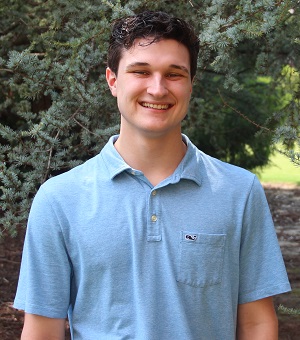Dreyfus Funding Supports Chemistry Undergraduate Research
Chemistry supports the W&M mission of enabling undergraduate research. Thanks to the generous support of the Camille and Henry Dreyfus Foundation, two research students are working in labs this summer. Dreyfus funding brings even more expertise to our department, via an Invited Lecturer, Dr. Richard Zare of Stanford University. His lectureship is funded by the Jean Dreyfus Lectureship for Undergraduate Institutions.
In February, rising juniors and seniors were invited to submit research proposals. Proposals detailed how their research would work, explained their plans after graduation and specified how their experiments align with the Dr. Zare’s lab focus. A faculty committee considered submissions and awarded two summer research fellowships: congratulations to rising chemistry seniors Daniel Costantino and Natalie Warren!
 Daniel’s research proposal, “Imaging the Collisional Dynamics of NO with Molecular Partners” is being conducted in Professor Nathan Kidwell’s lab. These experiments utilize molecular spectroscopy and velocity map imaging. Daniel’s work with nitric oxide (NO) can be applied to the evolution of smog and acid rain in our atmosphere and may help understand the roles NO and CO2 in atmospheric combustion. Back down at ground level, this project could also have consequences for improvement of engine efficiency due to the use of NO as diagnostic compounds in efficiency testing. Daniel plans on taking a gap year after graduating from W&M to acquire clinical experience, and then pursuing a MD/PhD to conduct medical research.
Daniel’s research proposal, “Imaging the Collisional Dynamics of NO with Molecular Partners” is being conducted in Professor Nathan Kidwell’s lab. These experiments utilize molecular spectroscopy and velocity map imaging. Daniel’s work with nitric oxide (NO) can be applied to the evolution of smog and acid rain in our atmosphere and may help understand the roles NO and CO2 in atmospheric combustion. Back down at ground level, this project could also have consequences for improvement of engine efficiency due to the use of NO as diagnostic compounds in efficiency testing. Daniel plans on taking a gap year after graduating from W&M to acquire clinical experience, and then pursuing a MD/PhD to conduct medical research.

Dr. Zare holds professorships in both the Departments of Chemistry and Physics at Stanford University. He has been awarded numerous honors, including the National Medal of Science and the National Academy of Sciences Award in Chemistry, and he is a fellow of the National Academy of Sciences and the American Academy of Arts and Sciences. The Zare Lab has made broad impacts in chemistry with the development of laser-induced fluorescence to study reaction dynamics, and his lab has made seminal contributions to our understanding of molecular collision processes.
Additionally, Zare Lab research explores wide-ranging questions relevant to sustainability. The work ranges from the study of elementary chemical reactions, to green chemical synthesis of compounds using water droplets, to devising analytical techniques to examine molecules in extremely tiny volumes- such as cells and subcellular units.
Our department is grateful for the support of the Camille and Henry Dreyfus Foundation and the Jean Dreyfus Lectureship for Undergraduate Institutions. Both students’ summer research lab opportunities will add to the understanding and well-being of your environment and future.
 Skip to main content
Skip to main content
